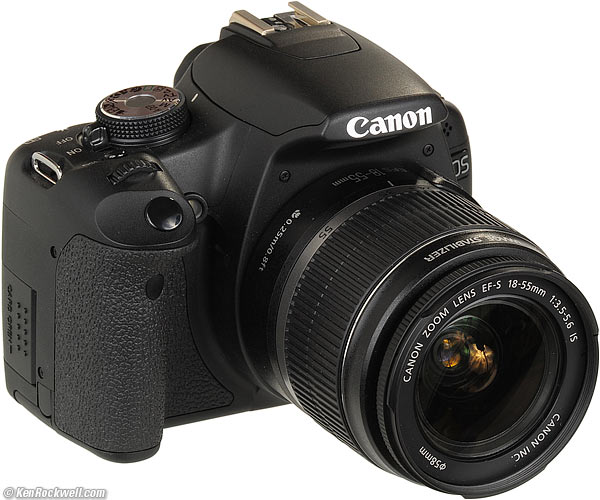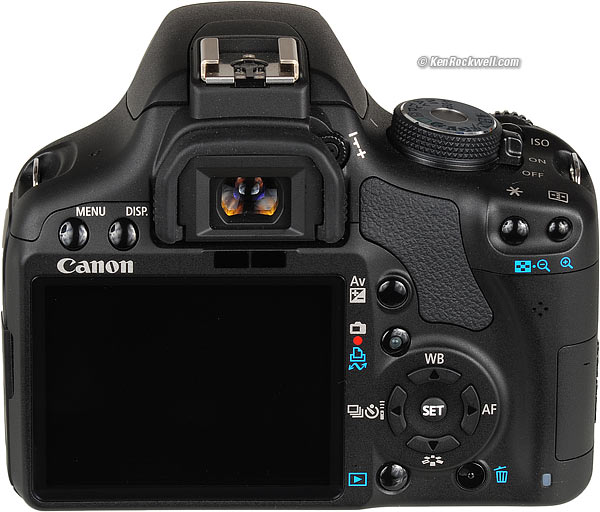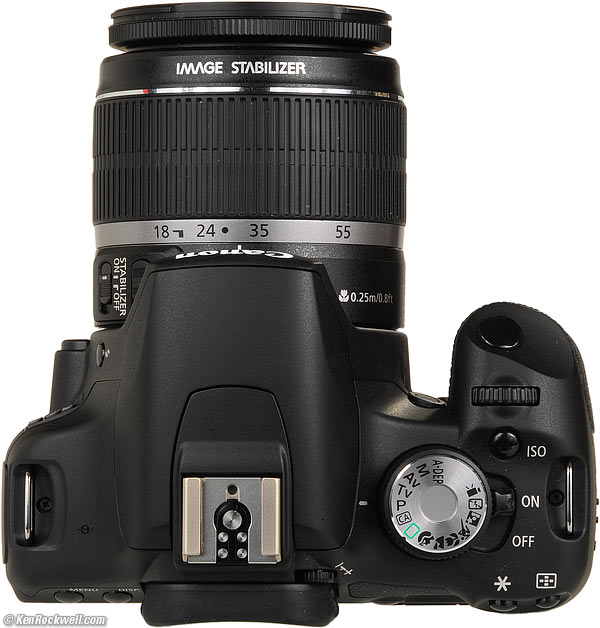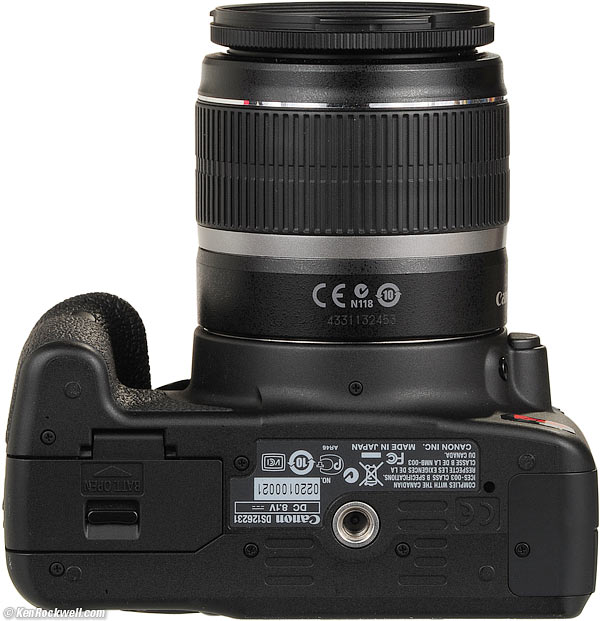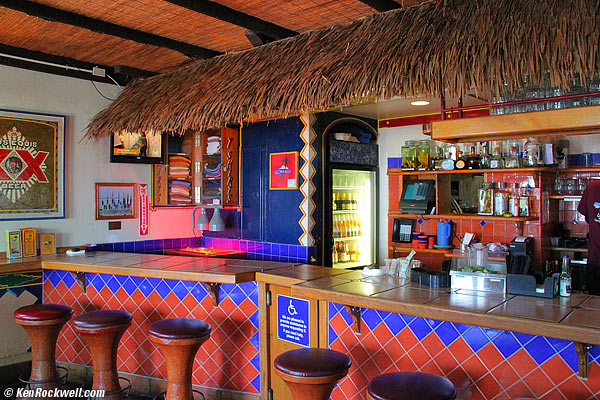Home Donate New Search Gallery How-To Books Links Workshops About Contact
Canon Digital Rebel T1i
(EOS 500D)
15MP, 3.4FPS, 3" LCD, Video, $800
© 2009 KenRockwell.com. All rights reserved.
Intro Specs Performance Usage Recommendations
Canon Digital Rebel T1i and 18-55mm IS (18.5oz/525g, body only with battery and card). enlarge. I'd get it at Adorama. It helps me keep adding this site when you get yours from this link, thanks! Ken.
July 2009 More Canon Reviews
Introduction top
Intro Specs Performance Usage Recommendations
The $800 Canon Digital Rebel T1i is Canon's second best digital camera ever, right behind the $2,700 5D Mark II, which is Canon's best, regardless of price.
What makes the T1i (and 5D Mark II) so good are how far improved their ergonomics are over earlier Canon DSLRs. Now it's easy to just shoot, where previous Canon DSLRs were always a pain in the neck, at least for me. The operation of the T1i is extremely well thought out.
Just tap the SET button and the rear panel comes alive with every possible setting you need to make. This is about two decades ahead of more primitive other models that required you to squint at tiny multi-function buttons on top of the camera. Forget that!
The T1i has a huge, sharp, bright, anti-reflection coated 3" LCD.
The Canon Digital Rebel T1i is also very light weight; it feels like it's all plastic, while in fact it has a metal lens mount and is made of very tough plastic. It's light, and it feels like it could take quite a beating.
A huge but subtle innovation, the first I've seen in any DSLR, is that you can hit the PLAY button as you hold the T1i in one hand, making this Canon's first DSLR certified for single-handed shooting. Other Canon SLRs, including the 5D Mk II, require a second hand to hit the play button to play, zoom and scroll, while you can do all that in one hand with the T1i.
Overall operation is as expected from Canon: colors look great, autofocus is instantaneous (but not always perfect, typical for Canon these past 20 years), and the readouts inside the finder are big and easy to read (bigger than in the 5D Mk II). The finder is very slightly bigger than the finder of the Digital Rebel XTi, but still tiny compared to full-frame cameras like the 5D digital and AE-1 Program 35mm camera.
Image adjustments, called Picture Style by Canon, are the same as other current Canons: you get up to ±4 for your selection of Contrast, Saturation, Color Tone (hue shift) and Sharpening (0-7).
The T1i even has a depth-of-field preview button.
New to this class of Canon is an Auto ISO setting. It works perfectly for use for scenic photos, but poorly for action. Better than Nikon, Canon's Auto ISO is simply another option in the ISO menu. Worse than Nikon, it cannot be adjusted for desired shutter speeds, which is why Canon's Auto ISO doesn't work for people photos, just scenic photos.
Canon's Auto ISO, while not adjustable, is much smarter than Nikon's because it automatically shifts itself based on your zoom setting. It doesn't know if you have IS on or off.
Canon's Auto ISO is optimized to choose lower, cleaner ISOs in exchange for the slowest shutter speed you can hold safely — if your subject holds still, too. If shooting people, kids or action, it will usually result in shutter speeds that are too slow in dim light.
For most people, this Canon Auto ISO system is superior because it's easier to use. For myself and the minority of you who learn Nikon's more complex system, Nikon's system is superior for people and action photos because the lowest desired shutter speed can be set to 1/125 (or anything else), and the Nikons will then use higher Auto ISOs than Canon to try to maintain 1/125 in lower light so people don't get smeared. Canon's Auto ISO will be perfectly happy shooting indoors at 1/30 at wider angles, and your non-flash people photos will be blurred.
Canon's "Highlight Tone Priority," a trick to prevent bright highlights from blowing out to white, and Auto Lighting Optimizer, a trick to keep shadows from getting too dark, really work¨.
The Auto Lighting Optimizer is always on by default, but you have to activate the Highlight Tone Priority manually in C.Fn II 6 (MENU > click left or right to the Wrench with three dots > Custom Functions > click right to #6 > SET > Click down to ENABLE > SET).
Highlight Tone Priority never lets the ISO go below 200 or above 3,200. If you have it ON, you'll see "D+" in the finder and on the LCD on playback if you're looking at shooting data.
The T1i has eye control: there is a magic sensor that always turns off the rear LCD when you bring the camera to your eye. It works only with the data screens; if you have an image up, it won't shut off by magic.
Rear, Canon Digital Rebel T1i. enlarge.
Specifications with commentary top
Intro Specs Performance Usage Recommendations
AF
9 point diamond, same as most other Canon SLRs the past five years.
Sensor
15MP CMOS.
sensor cleaner.
ISO
AUTO (changes with focal length, optimized for still subjects).
100, 200, 400, 800, 1,600, 3,200, 6,400, H (12,800).
Frame Rate
3.4 FPS maximum.
Maximum Shutter Speed with Flash
1/200 sync speed.
LCD
3."
920,000 dots.
640 x 480 VGA.
Anti-reflection coated.
Video
1920 x 1080 @ 20 FPS, 1280 x 720 @ 30 FPS and 640 x 480 @ 30 FPS.
Up to 4GB per clip, which is about 12 minutes at 1920 x 1080 @ 20 FPS, 18 minutes at 1280 x 720 @ 30 FPS, or 24 minutes at 640 x 480 @ 30 FPS. You'll get more time if your scenes are flat, and less if they are detailed and contrasty.
MOV format using MPEG-4 video
Sound: only as part of video.
Mono audio and microphone.
Sound: linear PCM without data compression, but with dynamic (AGC) level compression.
Weight
18.515 oz. (524.9g) measured with battery and SD card, but no lens, cap or strap.
Introduced
March 25, 2009
Price
$770 body only, , USA, 2009.
$850 with 18-55mm IS lens, USA, 2009.
Top, Canon Digital Rebel T1i. enlarge.
Performance top
Intro Specs Performance Usage Recommendations
The T1i is all about its improved ergonomics.
Fluff like video and pixels is irrelevant; the big LCD and easy-to-set settings are what make the T1i as good as it is.
Autofocus
AF is just like most Canons have been for years: nearly instantaneous, but not always correct.
AF is super fast, but sometimes focus will be a little off, even though you've been super careful and all the AF confirmation lights told you that the T1i thought it was in focus.
You rarely will see this, but if you go looking for it with lenses shot wide-open, you'll see it often with some lenses at some settings. The 18-200mm IS works great, but the 18-55mm IS often has problems at 18mm.
Color
Las Olas. Shot with 18-200mm IS at 80mm. enlarge.
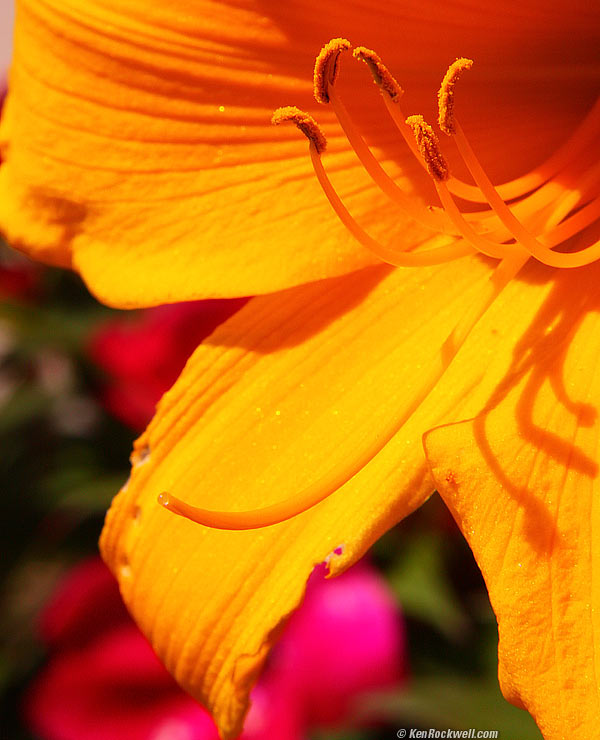
Flower, shot with 18-200mm IS.
The T1i has the same saturation ability and look as other recent Canons.
Set saturation to +4, and you get very vivid colors.
Ergonomics
Ergonomics are the best Canon has ever had. I covered most of this in the Introduction. My only major complaint is that Canon still requires you to hit PLAY after any shot before you can zoom or scroll it. Other than that, some nitpicks are:
You can hit PLAY with your shooting hand, but you still need a second hand if you want to hit MENU or DISP.
Hitting the SET button gets you to all the settings, but the T1i ignores the SET button unless you've woken it up first by tapping the shutter button. It has to do this, otherwise you'd keep turning it on by accident and run down the battery as you carried it around your neck.
When setting exposure compensation with the camera away from your eye, the graphic on the LCD should be bigger.
The black black dots and boxes that mark and light up to show the AF areas never go away; they are always in the viewfinder and clogging up your viewfinder as you're trying to compose.
The finder is very bright, even with slow (f/5.6) zooms.
Flash
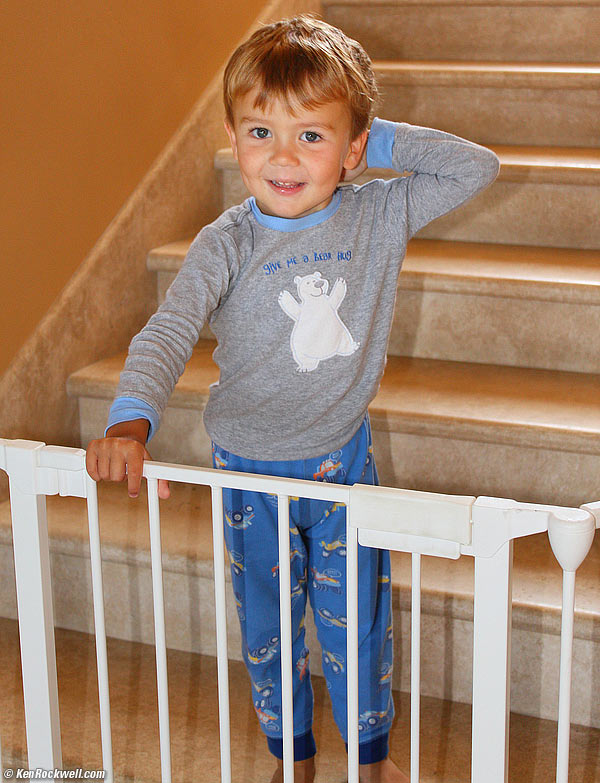
Ryan coming down the stairs: perfect fill flash! (Canon Digital Rebel T1i, built-in pop-up flash, 18-55mm IS.)
The Canon Digital Rebel T1i has the best flash exposure system of any Canon on which I've tried it.
Quite unusual compared to earlier Canons, I got perfect exposure every time with the built-in flash!
I couldn't fool it: I got perfect exposures when the flash was the only source of light, and perfect fill-flash when used to fill in shadows, indoors or out.
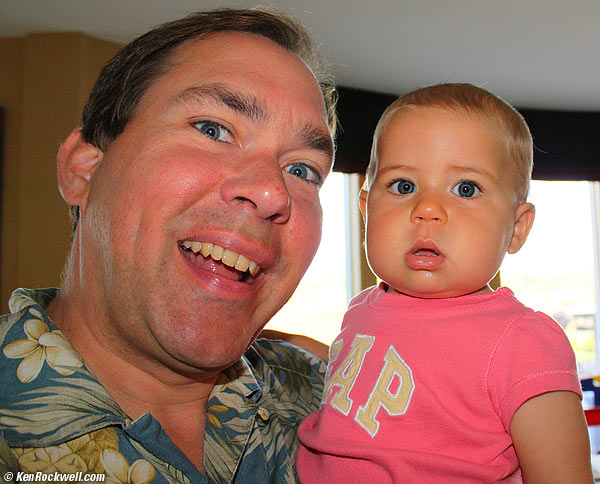
Baby Katie is horrified at how foolish dad can make himself look. (Self-portrait, Canon Digital Rebel T1i, built-in pop-up flash, 18-55mm IS.)
Yes, this is a scary photo, but the flash popped exactly the right amount of light on my face, while the background is perfect, too.
Daylight fill also works perfectly, however the little popup flash doesn't have enough power to work at more than about 5 feet in daylight with the slow 1/200 sync speed.
I had some great examples of fill flash at the beach when two teenage Russian girls in bikinis came over to me and asked me to take their pictures, but too bad for you, they preferred not to have their pictures strewn al over the Internet. Maybe next time, but I assure you, if I got close enough at the 18mm end of the zoom, fill worked great with no ned to fiddle.
Bottom, Canon Digital Rebel T1i. enlarge.
Technical Performance
This stuff is minor. It's the only thing over which most other non-photographer-written reviews obsess, but these technical minutiae have almost nothing to do with the quality of the actual photos you or I would ever take.
You can't see much of these details unless you're looking at images at 100% on your screen, in which case you'd need a 50" computer monitor (which doesn't exist) to see the complete image at that magnification. No video monitor has enough resolution, nor does any computer monitor have as many pixels as any of these cameras; digital projectors only have one megapixel!
Image Feel
If you're looking, the image files from the Rebel T1i looks poor at large magnifications. The common technical issues of noise and resolution and sharpness are fine. The problem is that the noise reduction is so strong, even at low ISOs, that while sharp edges remain sharp, even moderate textures get smoothed over.
To the educated observer, this makes the Rebel T1i images look as if they came from a point-and-shoot, with their need for severe noise reduction even at daylight ISOs.
This makes T1i images look slightly weird because the edges are all sharp, but distant bushes will have no texture, similar to cartoons. If you have grass and bushes receding into the distance, the close ones will show all the branches, and as they get farther away, suddenly all the details inside the bushes get smoothed over so they become green blobs, not bushes. Don't freak out; this is a subtle effect, but annoying once you learn to recognize it. Dealing with raw files instead of image files (JPG) may let you rectify this later in software; my life is too valuable to waste playing with raw files.
The 5D Mark II does this, too, but it can be reduced by turning off high ISO NR. Doing the same on the T1i doesn't improve anything. (to turn this noise reduction off for yourself, use C.Fn II 6 which you hit as MENU > click left or right to the Wrench with three dots > Custom Functions > click right to #5 > SET > Click down to DISABLE > SET)
This wouldn't be a problem for Canon if all DSLRs did the same thing, but if you worry about this, Nikons are a world better. Doing a direct comparison at my classified test range, results from a D300 look worlds better at 100%. The D300 looked like a real photo, and the T1i looked like a smudgy point and shoot.
Heck, when you add in the Canon's potential for autofocus misses, even some comparison shots from a 6MP Nikon D40 with its included free 18-55mm kit lens blown up to 15MP look better technically than the T1i and 18-55mm IS lens.
High ISOs
The T1i looks fine at ISO 1,600.
ISO 3,200 can look a little blotchy, but so what: so does every other non full-frame camera.
Even at ISO 3,200, it looks great for Internet use:
Bar, Las Olas, shot with 18-200mm IS at 18mm and f/5.6 at ISO 3,200. enlarge.
Skip ISO 6,400 if you can, and ISO 12,800 looks nasty. Use them if you have to, but expect very blotchy results. If you need to shoot up here, do yourself a favor and get a 5D Mark II instead.
Al the manually-set ISOs read-back perfectly in iView 3.
High ISO performance is the same as other half-frame DSLRs like the Nikon DX and other Canon 1.6x cameras. These cameras are a huge improvement over pocket cameras, but if you need a significant improvement over what any of this class of small-sensor DSLR can do, you need to step up to full-frame; even an old 5D is a class above. (I wouldn't use an old 5D; the old 5D is a total pain to use with an awful LCD and not at all like the superior current 5D Mark II.)
Resolution
15 Megapixels? Who cares?
6 MP is enough. All 15 MP does is fill up your cards and hard drive too fast, and take a lot longer to download. Few people realize that your computer screen and digital projectors are rarely more then one megapixel, and usually less. You only need 6 MP to print 20 x 30" (50 x 75cm), and the rest of the pixels are mostly for marketing cameras and to raise camera prices.
If you use really good lenses well and get perfect focus, yes, you can use all 15MP, but I would only do that if I were shooting scenic landscapes I intended to print huge.
I shoot the T1i at the lower resolution settings to save space.
If you really want to split pixels, you will need very good lenses. Unlike Nikon, Canon cameras cannot and do not automatically correct for corner color fringes. The 15MP setting of the T1i does a great job of letting you see minute limitations in your lenses more than giving you more details.
Sadly, the potential for AF system "misses" and Canon's inability to correct lateral color fringes due to lens limitations means that if you like to look at everything at 100%, the T1i looks a lot worse than a Nikon like the D5000, D90 and D300. These Gen II Nikons automatically fix these lens flaws, so the resulting images from Nikon cameras, if you're looking at 100%, are much better unless you're shooting $2,000 tele lenses ($2,000 wide zooms still need these corrections).
15MP is not the reason to get a T1i. 15MP is a marketing feature to draw the less well informed. The reason to get a T1i is its greatly improved usability.
Lateral Color Fringes
As mentioned above, Canon cameras can't fix lens limitations.
While modern (Gen II) Nikons eliminate color fringes automatically, any defects in your lenses will remain in your photos with the T1i, and if you're looking for them, 15 MP is going to show them on most lenses.
Live View
I don't use live view.
If you do, you may love the live RGB histogram that updates at 2fps.
Video
Video is much better than Nikon SLRs, but still bad.
If you want good video, do yourself a favor and buy a camcorder. Even the video or movie mode of your compact camera (like the tiny Canon SD780 IS) is usually better, and always far easier to use.
If Nikon and Canon promoted this feature accurately, they would say "We made made it nearly impossible to figure out how to shoot video, so you won't figure out how crappy it is until after your return period expires. Your videos will be out-of-focus and jumpy with thin mono sound, and your viewfinder blacks out when trying to shoot video anyway."
Video is out-of-focus because no DLSR can focus while shooting. You can't follow a moving subject with autofocus, but isn't that the whole point of video? If the subject holds still, why make a movie?
If you press the " * " button in movie mode it will autofocus, but it's slower and more confused than even Canon's very first EOS AF SLR from 1987 (22 years ago). I'm not kidding: I brought out an original EOS 620 from 1987 for comparison (the first EOS camera ever made, along with the EOS 650), and its AF system is far faster and surer than the Live View and movie AF of the Digital Rebel T1i! (Regular AF of the T1i is of course very fast.)
Video is jumpy because it's only 30 frames per second at best. Real video is 60 fields per second. Hollywood movies are 24 FPS, and they are a little jumpy, but that's part of their draw for drama.
Remember jumpy silent films, like Charlie Chaplin? Silent movies were shot at 18 FPS, very close to the 20 FPS of the T1i at 1920 x 1080. The video at 1920 x 1080 of the T1i looks like a strobe effect, and that's all it does. If nothing moves, it looks great, but if nothing moves, why shoot a movie? Sorry.
720 and 640 video are at 30 FPS and look fine, very similar to Hollywood movies, but not the smooth, live motion you get in a camcorder.
Forget shooting sports: the video is jumpy, and the viewfinder blacks out anyway. Don't worry, you can't focus fast enough on the T1i (or any DSLR) to make movies of sports anyway. The good news is that there is very little delay on the LCD; it's almost live.
I couldn't figure out how to get movies to go anyway. I had to search the Internet (easier than pulling out the manual) and realized that you select the movie mode on the mode dial. Once you figure that out, press the button on the back with the red dot to start and stop.
You select the video format in the first menu tab; the menu organization changes in each mode as selected on the top dial.
More good news versus Nikon is that the standard resolution video is a standard (for computers anyway) resolution: 640 x 480. Nikons use a screwy and almost useless 640 x 413 format!!!
Vertical lines stay reasonably vertical as you pan at reasonable rates, but if you pan too fast for audience comfort, you will get a minor Jello effect. Use any camcorder instead and this problem goes away.
Back to the bad autofocus: if you try to focus while rolling, you'll hear the lens focusing in your audio! If you zoom while rolling, you'll hear that in the audio, too. In case you all forgot, the only reason zoom lenses were invented was for movies, so if you can't zoom while you're shooting your movie, why bother shooting one?
Even if you didn't hear it in your audio, good luck trying to maintain focus while zooming in.
Audio has a weak low end. The automatic gain control rides up and down by itself with a long attack time. This means the first syllable of someone speaking can be distorted for a fraction of a second while the T1i turns down its gain after having ramped it up during silence.
Peripheral Illumination Correction
This ensures corners don't get too dark if you're also using most of up to 40 Canon EF and EF-S lenses.
I haven't tried it.
Usage top
Intro Specs Performance Usage Recommendations
I usually shoot the T1i set down to the 8MP (3,456 x 2,304 pixels) or 4MP (2,352 x 1,568 pixels) settings, and the stair-step (normal) instead of the default quarter-circle (fine) quality settings. This lets me make great-looking images that download a lot faster and don't clog my storage.
The stair-step icon means files are half the size, but still have the same sharpness, clarity and resolution of files shot at the default quarter-circle (fine) JPG setting. I can't see any difference in picture quality, but I can see a huge difference in file size, transfer speed and drive clogging.
I usually shoot in ISO AUTO, unless I'm shooting action indoors, in which I'll bump it straight to ISO 1,600 or 3,200.

Palm at standard Picture Style. (18-200mm IS at 35mm.)
I leave all the Picture Styles at their defaults, but set saturation to about +2 for people, and to +3 to +4 for other things I want to look colorful.
I set the white balance trim adjustment to A4 to give a warmer (more orange or Amber) look.

Saturation set to +4 in a user-defined Picture Style. (18-200mm IS at 35mm.)
The Picture Styles are set from the slanted-six-boxes-in-a-circle icon from the SET screen.
To see a screen with the clock, detailed picture settings, GB of remaining cardspace and other fun stuff, hit MENU and then hit DISP. You'll get text on a black screen that shows you how the camera is set, instead of the gray screen that allows you make settings when you hit SET.
Recommendations top
Intro Specs Performance Usage Recommendations
If you're in the Canon system and want a new body, go for it. There is no better LCD on any other Canon SLR, and weight and handling are the best Canon's ever offered.
I still prefer Nikon. I still find my Nikon D40 easier to use and carry, and it costs half as much. The results are about the same. I can pull great images out of any of these cameras.
If you demand more pixels and count every one, the Nikon D5000 (or equivalent D90 or D300) gives superior technical results from their lack of noise-reduction induced smudging, ability to correct lens defect color fringes and more reliable AF system. If you look at your photos at 100% on-screen, the Rebel T1i images look more like they came from a compact than an SLR.
If you already have Canon DSLRs, the T1i is a winner. I wouldn't buy one, but that's because I already have a 5D Mk II and a Digital Rebel XTi I never use and I prefer Nikon. If someone offered to trade me a T1i for my XTi, I'd do it in a second.
The reason to get this T1i is because of its greatly improved ergonomics. It just works better than earlier Canons.
Personally, I prefer Nikon, but if you look at sales figures, Canon sells a zillion cameras and all these people love them.
The very best Canon is the 5D Mark II, but its a lot more expensive and bigger.
For lenses, the 18-55mm IS isn't very exciting. It didn't always focus accurately at the wide end, leading to softer photos. I got much better and more consistent results with the 18-200mm IS.
In spite of my nitpicks, I'd have no problem turning out incredible images with a T1i and any Canon lens.
Help me help you top
I support my growing family through this website, as crazy as it might seem.
If you find this as helpful as a book you might have had to buy or a workshop you may have had to take, feel free to help me continue helping everyone.
If you've gotten your gear through one of my links or helped otherwise, you're family. It's great people like you who allow me to keep adding to this site full-time. Thanks!
If you haven't helped yet, please do, and consider helping me with a gift of $5.00.
The biggest help is to use this link to Adorama when you get your goodies. It costs you nothing and is a huge help. These places have the best prices and service, which is why I've used them since before this website existed. I recommend them all personally.
Thanks for reading!
Ken
Home Donate New Search Gallery How-To Books Links Workshops About Contact

